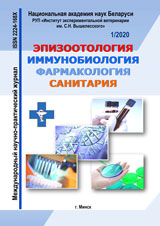
The journal "Epizootology Immunobiology Pharmacology Sanitation" presents the latest developments in the field of veterinary medicine, animal science, biology, medicine, immunobiology, genetic engineering, biotechnology, etc. The journal is indexed in the Russian Science Citation Index (RSCI). Full texts of articles are available on the website of the Scientific Electronic Library eLIBRARY.RU at: https://www.elibrary.ru/contents.asp?titleid=26806
Current issue
EPIZOOTOLOGY
The article notes the significance of the problem of tuberculosis for animals and humans, the need to carry out a set of organizational and economic measures, which are based on a routine examination of animals for tuberculosis, veterinary and sanitary inspection of carcasses and internal organs at slaughter, and laboratory tests.
The article presents the results of serological and virological monitoring of Newcastle disease among wild birds in the Republic of Belarus, taking into account the conditions of migration and the ecological and geographical features of the territory; the presence of a natural reservoir of the Newcastle disease virus in places of mass accumulation of birds during the migration and nesting period is proven.
Brucellosis is one of the most important problems in agriculture. This highly contagious infectious disease causes miscarriages in small and large cattle. In addition, it is easily transmitted to people through the consumption of milk and dairy products that have not been properly processed, as well as through direct contact with the biological fluids of infected animals. There are known cases of infection of veterinarians during obstetrics in cows and sheep, as well as laboratory workers. The incidence of brucellosis in farm animals in some regions of Azerbaijan is up to 15 %. Only timely and effective epidemiological surveillance of this disease and immunoprophylaxis can reduce the incidence of brucellosis.
This article is devoted to the assessment of the brucellosis surveillance system among farm animals in Azerbaijan during 2020–2022. The assessment of the epidemiological situation is based on the recommendations of the «Updated Guidelines for Evaluating Public Health Surveillance Systems» (US/CDC, Atlanta) and the data of the Electronic Integrated Diseases Surveillance System (EIDSS) [1, 3, 4].
Based on the analysis of the data, the epidemiological surveillance system of Azerbaijan, using the example of brucellosis incidence and corresponding vaccination, is recognized as effective. Based on the results of the study, recommendations are given to the epidemiological surveillance bodies of the republic.
Data on the main pathogens of infectious keratoconjunctivitis in cattle in the farms of the Republic of Belarus is given in the article. The main clinical symptoms are described, a brief description of the studied pathogens, such as Moraxella bovis and Moraxella bovoculi.
The aim of this research was to study the spread of actinobacillary pleuropneumonia in pig-breeding enterprises in Belarus, analyze various forms of clinical manifestations, prevention and treatment of this infection.
When conducting diagnostic tests in ELISA, a high percentage of antibody carriage was established – from 50 to 85 %, and the presence of the pathogen genome in PCR is no more than 70 %. In specific prevention, the highest effect is given by an autovaccine, and commercial toxoid monovaccines vary in effectiveness from 40 to 60 %, depending on the completeness of the antigens of the administered vaccine and the circulating pathogens in a particular herd. To treat sick animals, a therapy regimen using various antibiotics is used.
The article is devoted to a comprehensive study of bacterial and viral pathogens that cause respiratory diseases in cattle in Belarus. The main attention is paid to representatives of the Pasteurellaceae family (Pasteurella, Mannheimia) and molecular genetic diagnostic methods.
IMMUNOBIOLOGY
The conducted studies showed seropositivity of herds in the Republic of Belarus at the level of 96,2 %, while 21,8 % of positive samples of pathological material for the presence of the porcine parvovirus genome were detected. The designed oligonucleotides for detection of the porcine parvovirus genome in the real time polymerase chain reaction have high specificity and sensitivity at the level of 43 pg/ml of viral DNA.
The drug sensitivity of 34 strains cell wall deficient mycobacteria tuberculosis obtained experimentally and isolated from clinical samples in a diffusion test with antibiotic discs was studied.
CWD mycobacteria tuberculosis was resistant to penicillin, in 92,9–100 % of cases to streptomycin, 66,7– 100 % to kanamycin, neomycin, vancomycin and cephalosporins, but sensitive to tetracycline, doxycycline, linezolid, fluoroquinolones, rifampicin, but resistance to them appeared after 1-2 contacts with drugs, which it should be taken into account when developing new preparations, treating tuberculosis and preventing latent tuberculosis infection.
The article presents the results of testing laboratory samples of the «Kovpaste» vaccine on laboratory animals in the process of selecting optimal adjuvants when constructing a biopreparation. It was found that when developing a vaccine for the prevention of coronavirus infection caused by the SARS-CoV-2 virus and mink pasteurellosis, higher immunogenicity rates were obtained when using aluminum hydroxide gel at a 15 % concentration and a ratio of pasteurellosis and coronavirus components of 1:2.
FARMACOLOGY
The developed drug «Eprinovet» in a therapeutic dose of 20 mg/kg of body weight does not have a negative effect on the studied hematological and biochemical blood parameters in cattle. The effectiveness of the veterinary drug «Eprinovet» in a dose of 10 mg/kg and 20 mg/kg for gastrointestinal nematodoses of rearing calves was 100 %.
SANITATION
This paper contains the materials of research devoted to improvement of technological process of post-milking treatment of milk delivery lines. Its distinctive feature is the use of mechanical cleaning with a transformable device, which ensures a high sanitary and hygienic level of the milk delivery system – 2–7 RLU (4–12 CFU/cm2), a decrease in the level of total bacterial contamination from 81 to 67 CFU/cm3 and an increase in the production of raw milk of the «Extra» grade by 3,0–5,0 %. The use of our improved technological process provides a high sanitary and hygienic level of the milk delivery system.














